The Featured Creatures collection provides in-depth profiles of insects, nematodes, arachnids and other organisms relevant to Florida. These profiles are intended for the use of interested laypersons with some knowledge of biology as well as academic audiences.
Introduction
Cloudywinged whitefly, Dialeurodes citrifolii (Morgan), is one of the most common whiteflies associated with citrus in Florida. A native of Asia, it was described by Morgan in 1893 and later by Berger in 1909 from specimens collected in Florida.
Synonymy
Aleyrodes citrifolii Morgan 1893
Aleyrodes nubifera Berger 1909
Dialeurodes citrifolii (Morgan) (Jensen 2001)
Distribution
This species occurs in Barbados, Brazil, Bermuda, China, Cuba, Hong Kong, Jamaica, Japan, Malaysia, Puerto Rico, Trinidad, Venezuela, Vietnam, and the United States (Arkansas, Florida, Louisiana, North Carolina, Texas) (Mound and Halsey 1978).
Description
Adults
The adults are very small, yellowish, with a cloudy spot on the apex of the forewing and dusted with white powdery wax. When at rest the wings are laid back against the abdomen. Males are smaller than females, with the mean body length 1.28 mm for females and 1.04 mm for males (Quaintance and Baker 1917).
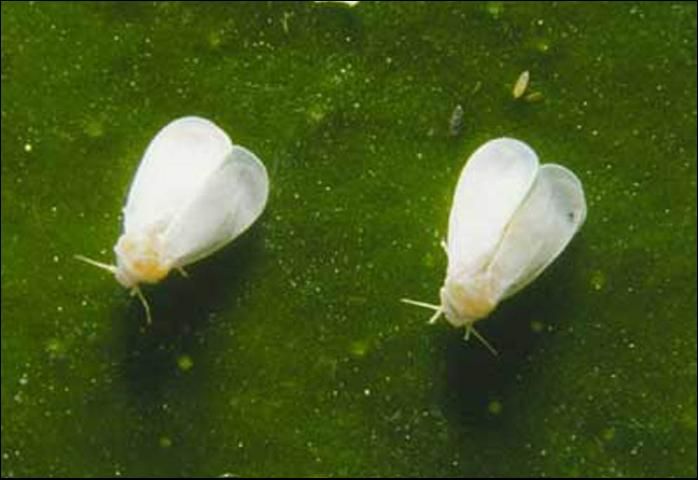
Credit: Ru Nguyen, Division of Plant Industry
Pupae
Pupae are oval, flattened, membranous, and yellowish-green without an orange spot on the back. The pupal case is opaque after emergence of the adult, and the case may collapse and lose its shape. Dialeurodes citrifolii pupae are readily confused with Dialeurodes citri, the citrus whitefly, but Dialeurodes citrifolii is said to be somewhat larger (Hamon 2001).
Nymphs
The immature stages are flat, elliptical in shape and light yellowish in color, and prefer the underside of the leaf. Three larval and one pupal stage occur in the life cycle. The first stage is 0.31 mm long and 0.20 mm wide, second stage 0.58 mm long and 0.38 mm wide, third stage 0.88 mm long and 0.66 mm wide, and pupa (4th stage) 1.44 mm long and 1.09 mm wide (Peracchi 1971).
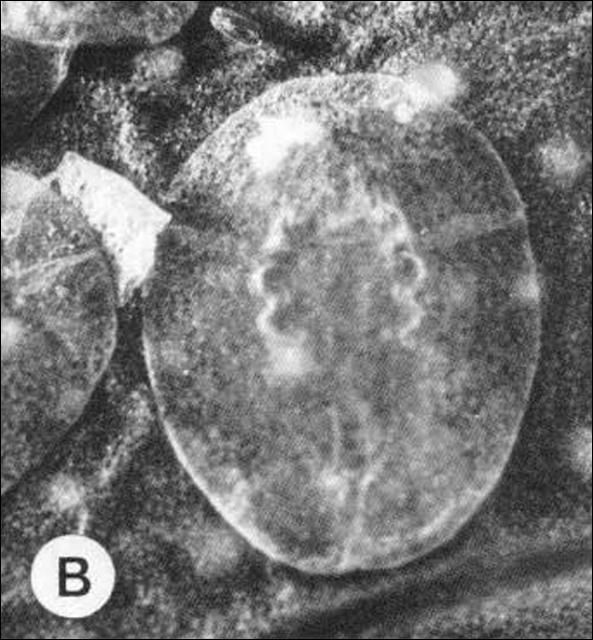
Credit: Division of Plant Industry
Eggs
The eggs are tiny (0.25 mm long), brown, elliptical, elongate in shape and most commonly laid on young leaves. The eggs can readily be separated from Dialeurodes citri because Dialeurodes citrifolii eggs are dark brown and have a hexagonal pattern on the surface, while Dialeurodes citri eggs are lighter in color and nearly smooth (Hamon 2001).
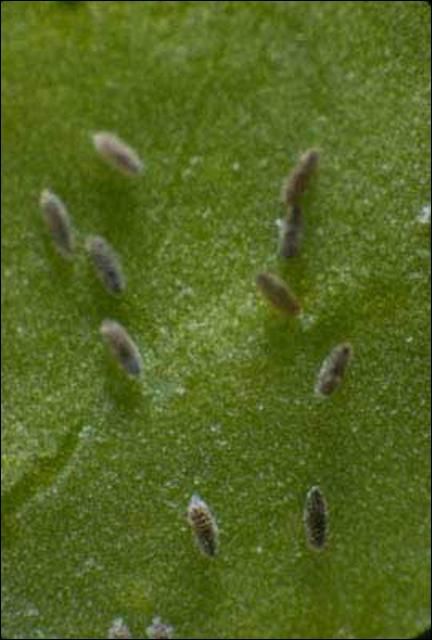
Credit: Ru Nguyen, Division of Plant Industry
The life cycle from egg to adult ranged from 51 to 334 days with three generations per year in Florida (Morrill and Back 1911).
Identification
The identification key provided here is designed to identify the four major species of whiteflies that commonly infest citrus in Florida. Another key that covers 16 species of whiteflies that may infest Florida citrus is available online. This key, developed by the Florida Department of Agriculture and Consumer Services' Division of Plant Industry, uses color photographs of nymphs to assist in identification. It is available at https://www.fdacs.gov/Agriculture-Industry/Pests-and-Diseases/Plant-Pests-and-Diseases/Citrus-Health-Response-Program/Key-to-Whitefly-of-Citrus-in-Florida.
1a. The whitefly adult is white or white with dark spots on the wings. Nymphs are difficult to see or identify. . . . . 2
1b. The whitefly adult is slate blue in color, eggs are present and laid in spirals. Nymphs are black with prominent spines. . . . . citrus blackfly
2a. The whitefly adult is all white without any dark spots on wings. . . . . citrus whitefly
2b. The whitefly adult is white with a darkened area at the end of each wing. Occasionally a yellow fungus is present. . . . . cloudywinged whitefly
2c. The whitefly female adult is all white and is surrounded by waxy filaments. Eggs are laid in a circle with the female at rest in the center. . . . . wooly whitefly
Economic Importance
The whitefly damages citrus by sucking sap from the leaves. Also, honeydew excreted by the whiteflies is a medium for the growth of sooty mold fungi. The sooty mold can cover the fruit and foliage so that it interferes with photosynthesis and requires that fruit be washed before marketing. In 1977, Encarsia lahorensis became established in Florida, and by 1980 had suppressed the population of Dialeurodes citri (Nguyen and Sailer 1979, Sailer et al. 1984). Since then, Dialeurodes citrifolii has gradually replaced Dialeurodes citri on citrus in central and southern Florida.

Credit: University of Florida
Hosts
Citrus is the most important host of this species. However, it can be found on Ficus nitida (Morrill and Back 1911) and Gardenia sp.
Natural Enemies
There are several natural enemies of Dialeurodes citrifolii, including:
- Parasites: Encarsia pertrenua (Silvestri) (reported in Vietnam) and Encarsia sternua (Silvestri) reported in Macao) (Silvestri 1927, Fulmex 1943).
- Predators: a lady beetle: Delphatus catalinae Horn (Mound and Halsey 1978).
- Pathogens: Aschersonia aleyrodis Webber, Aschersonia flavo-citrina B. Henning, and Aegerita webberi Fawcett (Pratt 1958). Aschersonia aleyrodis (red aschersonia) is the most common pathogen on Dialeurodes citrifolii in central and southern Florida.
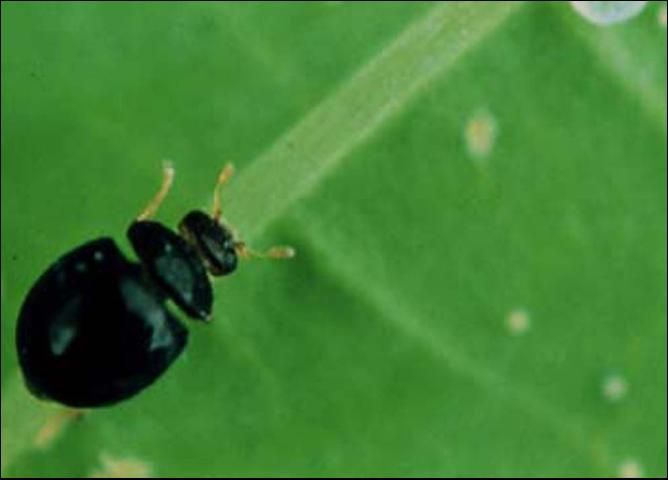
Credit: Kim Hoelmer, USDA
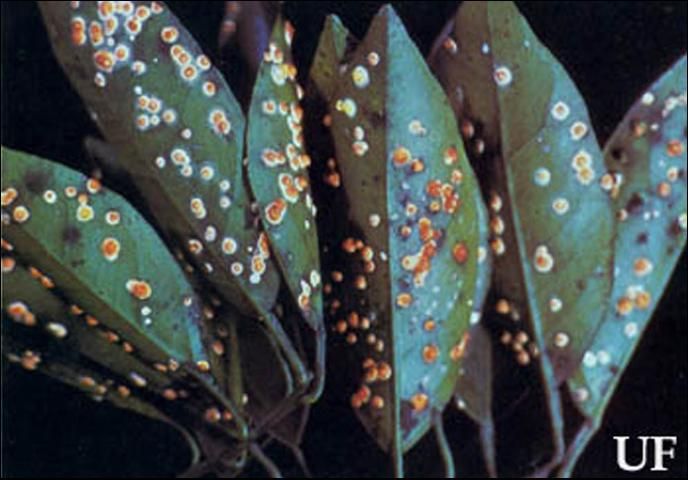
Credit: University of Florida
Chemical Control
Whiteflies also are controlled by sprays applied primarily for control of scale insects. Spraying of commercial citrus exclusively for whitefly control is seldom practiced in Florida. Recommended control measures for commercial or dooryard citrus are significantly different. Please consult the specific management guide for your situation.
Citrus Management Guide for Whiteflies in Commercial Groves
It is important to note that spraying with copper for control of harmful fungal diseases will also inhibit growth of beneficial fungi resulting in an increase in whitefly populations. Also, more than one application of sulfur per year can have an adverse effect on parasites. Spray oil has some insecticidal properties but is primarily used to remove sooty mold that grows on the fruit and leaves.
Selected References
Berger EW. 1909. Whitefly studies in 1908. Florida Agricultural Experiment Station Bulletin 97: 43–97.
Fasulo TR, Brooks RF. (2001). Whitefly pests of citrus. EDIS. (no longer available online)
Fulmex L. 1943. Virtsindex der Aleyrodiden - und Cocciden-parasiten. Entomol. Beih. Berl. Bahlem. 10: 30.
Hamon AB. (2001). Whitefly of citrus in Florida. Division of Plant Industry, FDACS. https://www.fdacs.gov/Agriculture-Industry/Pests-and-Diseases/Plant-Pests-and-Diseases/Citrus-Health-Response-Program/Key-to-Whitefly-of-Citrus-in-Florida (22 February 2022)
Jensen AS. 2001. A cladistic analysis of Dialeurodes, Massilieurodes and Singhiella, with notes and keys to the Nearctic species and description of four new Massilieurodes species. Systematic Entomology 26: 279–310.
Morgan HA. 1893. Aleyrodes citrifolii. pp. 70-74. In Stubbs WC, Morgan HA. The orange and other citrus fruits from seed to market, with insects beneficial and injurious with remedies for the latter. Special Bulletin of the Louisiana State Experiment Station.
Morrill AW, Back EA. 1911. Whiteflies injurious to citrus in Florida. USDA Bureau of Entomology Bulletin 92: 1–109.
Mound LA, Halsey SH. 1978. Whitefly of the World. A systematic catalogue of the Aleyrodidae (Homoptera) with host plant and natural enemy data. British Museum of Natural History, Chichester. 340 p.
Nguyen R, Sailer RI. 1979. Colonization of a citrus whitefly parasite, Prospaltella lahorensis, in Gainesville, Florida. Florida Entomologist 62: 59–65. (13 September 2016)
Peracchi AL. 1971. Dois Aleirodideos pragas de Citrus no Brazil (Homoptera: Aleyrodidae). Rio de Janeiro Mus. Nat. Archivos 54: 145–151.
Pratt RM. 1958. Florida guide to citrus insects, diseases and nutritional disorders in color. Florida Agricultural Experiment Station 191 p.
Quaintance AL, Baker AC. 1917. A contribution to our knowledge of the whiteflies of the subfamily Aleyrodinae (Aleyrodidae). Proceedings of the U.S. National Museum 51: 335–445.
Sailer RI, Brown RE, Munir B, Nickerson JCE. 1984. Dissemination of the citrus whitefly (Homoptera: Aleyrodidae) parasite Encarsia lahorensis (Howard) (Hymenoptera: Aphelinidae) and its effectiveness as a control agent in Florida. Bulletin of the Entomological Society of America 30: 36–39.
Silvestri F. 1927. Contribuzione alla conoscenza degli Aleurodidae (Insecta: Hemiptera) viventi su Citrus in Estremo Oriente e dei loro parassiti. Boll. Lab. Zool. Gen. Agr. R. Scuola. Agr. Protici. 21: 1–60.